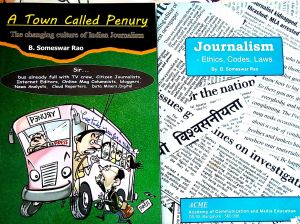
A ‘NATIONAL’ INDIAN DAILY (no, I don’t mean notional, though a 80-year-old typing on phone can make such mistakes) has shed copious tear, both in print and digital versions, over a ‘dancer’, known for vulgar record dances, not being allowed to dance in the plane on an international flight.
The same newspapers makes it a point to report every time Taimur Ali Khan Pataudi’s diaper is changed or he cried. The flirtations of film stars and idiotic speeches of morons passing off as leaders of political parties get most space in the print media or time on TV channels. We heard of Malala, the Pakistani girl shot by Taliban for seeking education for girls or the man who shared the Noel Prize with her, Kailash Satyarthi only after she was shot or he got the prize.
All that they did earlier was pushed out of news space by frivolities which do not “inform, educate or entertain” – the primary purpose of journalism .- Titillation or pandering to baser human cravings are things that boost up newspaper circulations or TV viewership ‘ratings’.
Unfortunately people at large are interested in glamour and reel heroes in place of real ones. And that is the main argument advanced by media for the new trend of sensationalization they indulge in. It is disgusting!
Recently I heard a discourse in which, departing from his usual religious issues, the speaker spoke of the respect that should be paid to the national flag, as Independence Day of India (August 15) was around the corner. He narrated the story of an Army officer who got a telegram that a son was born to him and was granted leave to visit home by his commanding officer. Just then a report of terrorist activity near the borders came. The CO told him to select some efficient and committed soldiers to be rushed to the spot.
The officer told his CO, “I can see my wife and son some other time, but I cannot see the national flag falling now.” He cancelled his leave, rushed to the troubled area, bravely fought the terrorists and shot them down. Just when he rose from his bunker, thinking all of them were down, one dying terrorist showered bullets on him. The officer died fighting for the country, without seeing his newborn son or the wife he married just the previous year.
“No Indian news channel or newspaper thought the news worth splashing. Not a word was heard or read about the brave act. The world came to know about it from a BBC bulletin,” the immensely popular speaker said.
This seems to be a world trend. Recently, an extremely popular American talk-show, EllenTube, had the host Ellen telling the audience that she would begin the day with good news. She picked up a daily newspaper, searched for good news in most pages and threw the daily down in disgust. All news items were about some evil even or the other.
Newspapers everywhere are facing existential crisis. Many are facing closure. Great ones like The Gaurdian have gone online and are appealing for public donations. Journalism in all media has lost its credibility. Social media news id quicker and more effective, but being un-regulated, gives scope to fake news.
In India newspapers like those run by Lokmanya Tilak, Agarkar, Prakasam or Motilal Nehru were a part of the freedom struggle. They were run with a purpose. I remember Mahatma Gandhi’s ‘Harijan‘ had a column titled “Weekly War News”, on Satyagraha in different part of the country.
The media’s argument “that is what the people want” to justify sensationalization and running after TRP (ratings) is the same as that used by bad film makers. It has been proved beyond doubt that if good films are made, people do see them. Only when some indulge in titillation and a few are creative does people’s taste degenerate. The fall in tastes and morality is a reflection of the failure of leadership in all fields.
Real leaders lead, not just follow popular trends.
